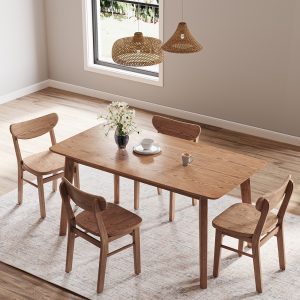Are you an environmentalist or a DIY lover? The sustainable furniture materials must be important element for you to pick up the home pieces, especially for a family with kids. Let’s take a look at sustainable selection tips.
The importance of sustainable materials in furniture
Here are some key reasons why sustainable materials are increasingly crucial in furniture:
- Environmental impact: The use of sustainable materials in furniture helps reduce the negative impact on the environment. By choosing materials that are renewable, recyclable, or biodegradable, we can reduce our carbon footprint and limit waste.
- Health benefits: Sustainable materials can improve the quality of the air we breathe in our homes. Many conventional furniture materials contain toxic chemicals, such as formaldehyde, which can contribute to poor indoor air quality and health issues.
- Longevity: Sustainable materials are often more durable than conventional materials, meaning they can last longer and require fewer replacements over time. This can save money and resources in the long run.
- Ethical sourcing: Sustainable materials are often sourced from ethical and responsible suppliers, ensuring that workers are treated fairly and working conditions are safe.
- Consumer demand: As more consumers become aware of the environmental and health impacts of conventional furniture materials, there is increasing demand for sustainable alternatives. By choosing sustainable materials, furniture companies can meet this demand and appeal to eco-conscious consumers.
What can be called as sustainable materials?
Sustainable materials, also called eco-friendly materials, are materials that are sourced, produced, and used in a way that minimizes their impact on the environment, while also being socially responsible and economically viable. In addition, the sustainable furniture design can be casual or elaborate, which is indefinite.

Characteristics of sustainable materials of furniture or home decors:
- Renewable: Sustainable materials are often made from renewable resources that can be replenished naturally over time, such as bamboo or cork. This means that the production of these materials is less likely to deplete natural resources and cause long-term environmental harm.
- Recyclable: Sustainable materials are often designed to be easily recyclable or reusable, which reduces waste and conserves resources. For example, recycled plastic can be used to create new products, while reclaimed wood can be repurposed for furniture or building materials.
- Non-toxic: Sustainable materials are typically free from toxic chemicals or substances that can harm the environment or human health. This includes materials that are produced without harmful pesticides or synthetic chemicals, or that do not emit harmful pollutants or VOCs (volatile organic compounds).
- Energy efficient: Sustainable materials are often produced using energy-efficient methods or with renewable energy sources. This reduces the overall carbon footprint of the material and helps to conserve energy resources.
- Ethically sourced: Suppliers who utilize fair labor practices and ethical business practices often source sustainable materials, ensuring that they treat workers fairly and do not contribute to social or environmental harm during the production of the materials.
- Durable: Sustainable materials last longer, reducing replacements and conserving resources. Sustainable furniture withstands wear and tear and resists damage from elements.
Factors to consider when choosing sustainable materials for furniture
When choosing sustainable materials for furniture, there are several factors to consider. Keep those factors in mind:
- Material source: Consider where the materials are sourced from and whether they are produced in a sustainable way. Look for materials that are sourced from renewable resources, such as bamboo or cork, or materials that are reclaimed or recycled.
- Production process: Think about how materials are made. Check if the process is eco-friendly and uses less energy. Choose sustainable materials like those made using renewable energy or with minimal waste.
- Durability: Consider how durable the materials are and whether they are able to withstand wear and tear over time. Look for materials that are designed to last, such as solid wood or metal, and that are resistant to damage from the elements or use.
- Non-toxicity: Consider whether the materials are non-toxic and free from harmful chemicals. Look for materials that are produced without the use of harmful pesticides or synthetic chemicals, or that do not emit harmful pollutants or VOCs (volatile organic compounds).
- Recycling or disposal: Consider how the materials can be recycled or disposed of at the end of their life. Look for materials that are easily recyclable or compostable, or that can be repurposed or reused in other ways.
- Cost and availability: Consider the cost and availability of the materials, and whether they are accessible and affordable. Look for materials that are cost-effective and widely available, and that are comparable in price to conventional materials.
Anyway, choosing sustainable materials for furniture requires careful consideration of a range of factors. By selecting materials that meet these criteria, we can create furniture that is not only beautiful and functional, but also environmentally friendly and socially responsible.

Frequently-used material types of sustainable furniture
- Bamboo: Bamboo is a rapidly renewable resource that grows quickly and doesn’t require the use of harmful pesticides or fertilizers. It can be used to make furniture that is lightweight, strong, and durable.
- Reclaimed wood: Reclaimed wood comes from old buildings or wood waste. People salvage it instead of throwing it away. Reclaimed wood use saves energy and reduces demand for new wood.
- Cork: Cork comes from the bark of cork oak trees and doesn’t harm them. It’s sustainable. Cork is lightweight, water-resistant, and durable. People can make furniture from cork.
- Recycled plastic: Recycled plastic is made from post-consumer plastic waste, such as bottles and containers. Using recycled plastic in furniture reduces the demand for new plastic and reduces the amount of plastic waste that ends up in landfills or oceans.
- Organic cotton: Organic cotton is grown without the use of harmful pesticides or fertilizers, making it a more sustainable alternative to conventional cotton. It can be used to make furniture upholstery or bedding.
- Natural fibers: Natural fibers, such as jute, sisal, and hemp, are renewable resources that can be used in furniture. They are biodegradable and can be sustainably grown without the use of harmful chemicals.
- Glass: Glass is a durable, recyclable material that can be used to make furniture, such as tabletops or shelves.

These are just a few examples of sustainable materials that can be used in furniture. Using sustainable materials is an important step towards creating a more sustainable and environmentally friendly home.
Assessing certifications and labels
There are several certifications and labels related to sustainable materials for furniture that can help consumers identify products that are environmentally friendly.
Check the most common certifications and labels:
- Forest Stewardship Council (FSC): The FSC is an international non-profit organization that promotes responsible forest management. Products that carry the FSC label are made from wood that has been responsibly sourced and harvested from FSC-certified forests.
- Cradle to Cradle Certified (C2C): The C2C certification sets a standard for environmentally conscious product design. Products with the C2C label must be recyclable or reusable and produced using sustainable practices.
- Global Organic Textile Standard (GOTS): The GOTS certification sets a standard for products made from organic fibers. Products with the GOTS label must use materials grown without harmful pesticides or synthetic fertilizers, and they must be produced using sustainable and socially responsible practices.
- Greenguard Certification: The Greenguard certification is a standard for products that meet strict standards for indoor air quality. Products that carry the Greenguard label are free from harmful chemicals and emissions, and are designed to promote healthy indoor environments.
- Energy Star: The Energy Star label is a standard for energy-efficient products. The Energy Star label products use less energy than conventional products. This reduces greenhouse gas emissions and conserves natural resources.
- LEED Certification: The Leadership in Energy and Environmental Design (LEED) certification is a standard for sustainable building design and construction. Furniture made from recycled materials or FSC-certified wood are products designed to meet strict sustainability and environmental responsibility standards for LEED certification.
Those certifications and labels related to sustainable furniture can help consumers make informed choices about the products they buy. However, some furniture stores have not applied for those certifications so it does not mean they are not sustainable.
Practical Tips for finding sustainable furniture
- Look for certifications and labels: As mentioned in the previous answer, certifications and labels such as FSC, C2C, GOTS, Greenguard, Energy Star, and LEED can help you identify products that are environmentally friendly and socially responsible.
- Research materials: Look for furniture made from sustainable materials such as bamboo, cork, reclaimed wood, recycled metal, or organic textiles. Consider the production process and whether it is energy-efficient and environmentally friendly.
- Choose local: Look for furniture made by local artisans or companies. This can help reduce the carbon footprint associated with transportation and support local economies.
- Buy secondhand: Consider buying secondhand furniture instead of new. This can help reduce waste and support the circular economy. The used furniture owns less pungent smells.
- Check the company’s sustainability practices: Research the company’s sustainability practices, such as whether they use renewable energy, recycle waste, or source materials responsibly. Look for companies that prioritize sustainability and social responsibility in their operations.
- Consider durability: Look for furniture that is designed to last and withstand wear and tear over time. This can help reduce waste and ensure that your furniture has a long lifespan.
- Think beyond aesthetics: While the aesthetics of furniture are important, also consider the environmental impact and social responsibility of the products you are considering. Prioritizing sustainability and social responsibility in your furniture choices can help create a more sustainable and equitable future.
